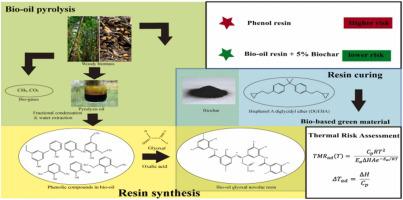当前位置:
X-MOL 学术
›
Process Saf. Environ. Prot.
›
论文详情
Our official English website, www.x-mol.net, welcomes your feedback! (Note: you will need to create a separate account there.)
Assessing thermal hazards in bio-oil-glyoxal polymerization and curing with DGEBA and bio-char
Process Safety and Environmental Protection ( IF 6.9 ) Pub Date : 2024-03-30 , DOI: 10.1016/j.psep.2024.03.096 Jie Xu , Nicolas Brodu , Lokmane Abdelouahed , Bechara Taouk
Process Safety and Environmental Protection ( IF 6.9 ) Pub Date : 2024-03-30 , DOI: 10.1016/j.psep.2024.03.096 Jie Xu , Nicolas Brodu , Lokmane Abdelouahed , Bechara Taouk

|
Traditional novolac resin uses formaldehyde and an excess of phenol under an acid catalyst which has a remarkable production and wide applications, however, the polymerization and its curing reaction are highly exothermic and heat generation with the release of harmful gases (formaldehyde and phenol) link to a high potential of thermal runaway hazard and the possibility of explosions in resin factories. To make a sustainable novolac-type resin, the water-insoluble fraction of bio-oil glyoxal (BOG) resin was utilized as an ideal phenol bioresource. The safety criteria of renewable resins polymerization and its curing reaction were investigated using the Differential Scanning Calorimeter (DSC) and evaluated by comparing the critical runaway conditions with those of traditional non-renewable resins. The reaction mechanism of the novolac resin synthesis and curing reaction were discussed as well. The results indicate that the use of bio-oil can reduce the heat risk of polymerization reactions. The introduction of biochar for the first time in curing reactions has shown a potential beyond anticipation in reducing the heat risk of curing reactions.
中文翻译:

评估生物油-乙二醛聚合和使用 DGEBA 和生物炭固化的热危害
传统的酚醛清漆树脂在酸催化剂作用下使用甲醛和过量的苯酚,其产量显着,应用广泛,但聚合及其固化反应是高度放热和放热的,并释放出有害气体(甲醛和苯酚),导致树脂工厂存在很高的热失控危险和爆炸可能性。为了制造可持续的酚醛清漆型树脂,生物油乙二醛(BOG)树脂的水不溶性部分被用作理想的苯酚生物资源。使用差示扫描量热仪(DSC)研究了可再生树脂聚合及其固化反应的安全标准,并通过与传统不可再生树脂的临界失控条件进行比较来进行评估。还讨论了酚醛树脂合成和固化反应的反应机理。结果表明,使用生物油可以降低聚合反应的热风险。首次在固化反应中引入生物炭在降低固化反应的热风险方面显示出超出预期的潜力。
更新日期:2024-03-30
中文翻译:

评估生物油-乙二醛聚合和使用 DGEBA 和生物炭固化的热危害
传统的酚醛清漆树脂在酸催化剂作用下使用甲醛和过量的苯酚,其产量显着,应用广泛,但聚合及其固化反应是高度放热和放热的,并释放出有害气体(甲醛和苯酚),导致树脂工厂存在很高的热失控危险和爆炸可能性。为了制造可持续的酚醛清漆型树脂,生物油乙二醛(BOG)树脂的水不溶性部分被用作理想的苯酚生物资源。使用差示扫描量热仪(DSC)研究了可再生树脂聚合及其固化反应的安全标准,并通过与传统不可再生树脂的临界失控条件进行比较来进行评估。还讨论了酚醛树脂合成和固化反应的反应机理。结果表明,使用生物油可以降低聚合反应的热风险。首次在固化反应中引入生物炭在降低固化反应的热风险方面显示出超出预期的潜力。
















































 京公网安备 11010802027423号
京公网安备 11010802027423号